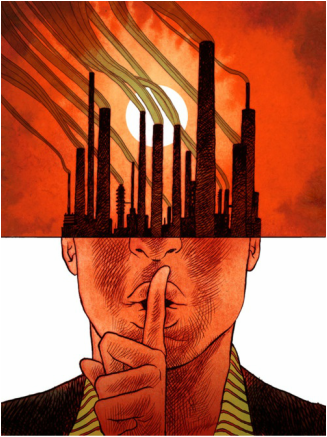 Atmospheric CO2 is at 400 ppm & climbing (Image credit: Koren Shadmi) Atmospheric CO2 is at 400 ppm & climbing (Image credit: Koren Shadmi)
Tags: capitalism, corporations, environment, buen vivir, climate change, climate crisis, climate justice, corporate social responsibility, environmentalism, extractivism, false solutions, fracking, global warming, political ecology, tar sands, 00 to 05 mins
Year: 2015 Length: 3:06 Access: YouTube Summary: In January 2015, scientists recorded atmospheric levels of carbon dioxide above 400 parts per million on a regular basis—the first time such a level had been detected so early in the calendar year. It is well established that levels of CO2 above 350 (already well above the pre-industrial norm of 275 ppm) spur global warming. As observed in Texas, Oklahoma, California, and countless other places around the world, we are now experiencing the effects: extreme weather, droughts, rising sea levels, thawing permafrost, etc. Levels above 450 will most likely put the planet on an inescapable course toward catastrophic climate change. • 400 ppm is an eco-political music video, which encapsulates the climate crisis and climate justice in just three minutes. It is an intervention in popular political ecology/economy, aimed at those who are uneasy with the increasingly obvious deterioration of the living systems of which we are an inextricable part. It might also be a useful way of beginning a critical discussion about the human causes of climate change. • The song begins from basic observations—symptoms of the crisis—and then shifts to the ideological problem of denial, softened in recent years by massive corporate social responsibility advertising and complemented by the emergence of ‘silver-bullet’ geo-engineering schemes. At the song’s midpoint, its bridge identifies the structural drivers of the crisis: carboniferous capitalism, and the contradiction between compounding capital accumulation and the principle of homeostasis which governs the biosphere. The next verse underlines that point and invokes, with the wheel of fortune, a financialized casino-capitalism inured to its material ‘externalities.’ Wes Carroll’s spirited guitar solo is accompanied by images from Canada’s notorious Tar Sands, of bitumen extraction and what it leaves behind. But at this point the video begins to arc toward hope, with footage from the Tar Sands Healing Walk (featuring Cree activist and writer Clayton Thomas-Muller)—an annual event since 2010 bringing together Indigenous activists, environmentalists and others. • The last verse gestures toward a just transition—a power shift—to a post-capitalist future that combines global justice and solidarity with ecological stewardship, and that abandons the consumer-capitalist logic of always having more, in favor of buen vivir: ‘living well.’ To get there, we had better start healing what Karl Marx called the metabolic rift between capitalist extractivism / accumulation and the conditions for a vital ecosystem. Mass popular struggle, building on but going beyond the September 2014 People’s Climate March (the final image), is a necessary condition for such a radical remaking of our world. Submitted By: Bill Carroll
3 Comments
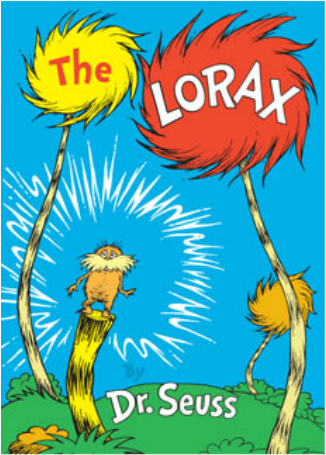 The Lorax warns that industrial activity will destroy our natural environment. The Lorax warns that industrial activity will destroy our natural environment. Tags: capitalism, consumption/consumerism, economic sociology, environment, theory, ethical consumption, externalities, industrial production, ipat formula, markets, 21 to 60 mins Year: 1972 Length: 25:13 Access: YouTube Summary: Written by Dr. Seuss, The Lorax is a children's book that tells the story of a stereotypical industrialist who clear-cuts a forest of trees to produce "Thneeds" for growing consumer markets. The Lorax, who "speaks for the trees," continuously but unsuccessfully explains that the industrial activity is destroying the forest and the homes of its many animals. The industrialist, Mr. Onceler, explains he is only "meeting consumer demand" and that "if I didn't, someone else would." But eventually, the trees are gone and the landscape is destroyed, thus making Mr. Onceler's business go bankrupt. Seeing the errors he made, Mr. Onceler encourages a boy passing by to plant new Truffula trees and regrow the forest. The original cartoon based on the book offers a familiar and entertaining way to discuss the relationship between industrial production, consumption, and environmental problems (note the cartoon was more recently made into a computer-animated film with 70+ controversial product-placements, offering additional points of discussion). The cartoon illustrates many key concepts, including the externalization of environmental costs, the consumer demand that partially drives the treadmill of production, and the popular IPAT forumla (Impact = Population X Affluence X Technology) for conceptualizing factors that explain environmental degradation. However, as Maniates (2001) argues in "Individualization: Plant a Tree, Buy a Bike, Save the World?," the story narrowly suggests individualistic solutions. He argues the proposed "response half-consciously understands environmental degradation as the product of individual shortcomings (the Once-ler's greed, for example), best countered by action that is staunchly individual and typically consumer-based (buy a tree and plant it)" (pp. 32-33). As such, the video can be used to distinguish the individualist explanations of production and consumption, from the more sociological explanations that link Mr. Onceler and the Lorax's activities to broader structural and institutional forces (and the limits of consumer-driven prospects for change). Maniates further notes that the popular IPAT formula excludes several important factors related to power and governance that impact environmental degradation. Another interesting theme, noted by Maniates (p. 32), is the "seeming inability of science (represented by the fact-spouting Lorax himself) and objective fact to slow the damage." Submitted By: Paul Dean  Political agendas enter into scientific discourse. Political agendas enter into scientific discourse. Tags: corporations, environment, government/the state, politics/election/voting, science/technology, campaign financing, climate change, global warming, house of representatives, political bias, 06 to 10 mins Year: 2014 Length: 10:25 Access: The Daily Show Summary: This segment from The Daily Show spotlights a recent hearing of the U.S. House Committee on Science, Space, and Technology, in which President Obama's plan to decrease carbon emissions by 30% by 2030 was discussed. The video would be useful for explaining political bias, the relationship between wealth and power, and the power of corporations in elections. The clip includes footage from the hearing, in which several politicians interrogate Presidential Science Advisor John Holdren about whether climate change is a reality, despite the fact that, by now, the scientific literature has overwhelmingly shown that climate change is a massive global threat for humanity. In this video, U.S. Representatives Steve Stockman (R-Texas) and Larry Bucshon (Indiana-R) refute global warming, despite their inability to provide viable evidence. Indeed, Congressman Bucshon argues that people should trust public comments rather than scientific literature because, in his opinion, “The climatologists...depend on the climate changing to keep themselves publishing articles." He concludes that, "I could read that, but I don’t believe it.” At the end of the clip, Jon Stewart points to Stockman's interest in denying climate change, revealing that his three major campaign donors are big energy companies. This video would work well in combination with another clip on The Sociological Cinema, which illustrates how, despite overwhelming scientific evidence, powerful interests are able to suppress knowledge by introducing doubt into public discourse. Submitted By: Nihal Çelik  Doubt shapes discourses of science and power. Doubt shapes discourses of science and power. Tags: discourse/language, environment, foucault, health/medicine, knowledge, science/technology, social construction, climate change, creationism, evolution, tobacco, 00 to 05 mins Year: 2012 Length: 5:12 Access: YouTube Summary: This video from The Climate Reality Project entitled "Doubt" illustrates how knowledge and power are tightly interwoven. Using two case studies—the "tobacco is good for you campaign" and the "climate change denial movement"—the clip depicts how science can be used as a mechanism of legitimation by powerful others in ways that best serves status quo interests. Michel Foucault discussed this phenomenon in his extensive work on how the discourse of science (and knowledge) is also a discourse of power. As illustrated in the video, despite the scientific evidence showing tobacco's deadly effects and climate change's dangerous outcomes, powerful interests suppressed this knowledge by introducing doubt into the discourse around tobacco use and climate change, which they backed up using a discourse of science. These powerful interests created the illusion that a scientific debate was taking place when, in reality, there wasn't. An iteration of this phenomenon recently unfolded in the media-hyped debate between Bill "the Science Guy" Nye and creationist Ken Ham. Here, the case of evolution was presented as a scientific debate, thereby suggesting that a lack of consensus surrounds the scientific evidence around evolution. This tactic of using a discourse of science to create the illusion of uncertainty around evolution was echoed by Michael Schulson in his article for The Daily Beast, in which he writes: "Ham’s argument, essentially, was that there are two kinds of science—observational, concerned-only-with-what-we-can-touch-and-see science, on which, Ham said, we all happily agree; and historical science, on which we don’t. This is bullshit, of course. We can use evidence from the present to extrapolate about the past." Yet, like the case of tobacco and climate change, by creating doubt about the earth's origins, the public's access to scientific knowledge is suppressed. This video would complement a discussion around the sociology of knowledge, science, and power, and would pair well with portions of the This American Life radio episode, "Fake Science," and with sociologist Zuleyka Zevallos's article, "The Sociology of Why People Don’t Believe Science." Viewers can be encouraged to think about: Whose interests are served in each of the fake science cases of tobacco, climate change, and evolution? What is the role of the media in perpetuating fake science? How has fake science shaped social policy? Other videos from The Climate Change Project can be found here. Submitted By: Valerie Chepp  "The Scarecrow" explores the McDonaldization of society "The Scarecrow" explores the McDonaldization of society
Tags: capitalism, consumption/consumerism, corporations, environment, food/agriculture, marketing/brands, organizations/occupations/work, science/technology, theory, weber, farming, fordism, george ritzer, mcdonalidzation, rationalization, slow food, subtitles/CC, 00 to 05 mins
Year: 2013 Length: 3:23 Access: YouTube Summary: "The Scarecrow" is Chipotle's most recent commercial exploring the American dependency on highly rationalized farming techniques, which offend human conscience and wreak havoc on the environment (Note that Chipotle created a commercial with similar themes back in 2011). This animated short takes place in a dystopian universe where scarecrows punch in each day at a factory run by their crow overlords, and crow surveillance drones caw whenever production slows. The video is a useful illustration of what George Ritzer has called the McDonaldization of society, which refers to "the process by which the principles of the fast-food restaurant are coming to dominate more and more sectors of American society." Ritzer explains that McDonaldization is characterized by efficiency, calculability, predictability, and control. In and around the barren landscape owned by Crow Foods, one finds examples of efficiency everywhere. Conveyer belts efficiently move workers to their various stations in the factory, and livestock are stacked in crates, one on top of the other—an efficient use of factory space. Scanning the inner workings of the factory, it appears that ground beef, chicken, and pork are being squeezed through narrow chutes, and large blades worthy of a guillotine slice the meats into slabs with such precision that one could easily calculate and predict the amount of meat produced in any given hour. Controlling the pace of production is as easy as pulling a lever. While the video is quite literally Chipotle's straw man fantasy and is created with the aim of developing the Chipotle brand as a healthy, environmentally-friendly meal choice, the McDonaldization of food production is a very real phenomena and one sociologists take very seriously (The Sociological Cinema has also explored the issue here and here). What could be more important than understanding how a system, which was ostensibly developed to nourish vast numbers of people, is actually harmful to human health? Submitted By: Lester Andrist 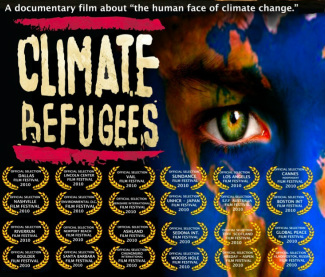 This trailer and film examine the human face of climate change. This trailer and film examine the human face of climate change. Tags: environment, globalization, immigrants/citizenship, climate change, climate justice, migration, refugees, 00 to 05 mins, 61+ mins Year: 2010 Length: 3:03 Access: YouTube Summary: While the science behind climate science clearly shows that climate change is caused by humans (see summary of the 2013 IPCC report), its actual effects on humans is often harder for people to understand. One of the many effects of climate change, however, is the emergence of climate refugees. As defined by the creators of this film by the same name, "a climate refugee is a person displaced by climatically induced environmental disasters. Such disasters result from incremental and rapid ecological change, resulting in increased droughts, desertification, sea level rise, and the more frequent occurrence of extreme weather events such as hurricanes, cyclones, fires, mass flooding and tornadoes. All this is causing mass global migration and border conflicts." Accordingly, this trailer puts the human face back into climate change to emphasize the impact it is having on over 25 million people now, and these impacts will only continue to grow. But its impact will not only be felt by the refugees themselves, but also the societies that volunteer, or are forced to accept the mass movement of people into their countries. As John Kerry notes in the trailer, it is an "enormous national security issue." It will have further effects on food and energy prices throughout the world. You can also watch the full film (95 minutes) online. Viewers may also be interested in this second video (2013; 47 seconds) that briefly describes the first American town that will likely be lost to climate change by 2025. Kivalina, Alaska, sits on a small peninsula and is home to 400 indigenous peoples. For generations, they have depended on the sea for their survival, but because of greenhouse gases produced by other people around the world, they will lose their homes to that sea. The broader issue of climate refugees raises many important ethical questions as well. Given that the populations displaced by climate change (mostly in the Global South) have contributed far less to global warming, what responsibilities do those in the Global North--who are largely responsible for greenhouse gas emissions--have in protecting or moving these populations? In other words, what would climate justice look like? Submitted By: Paul Dean 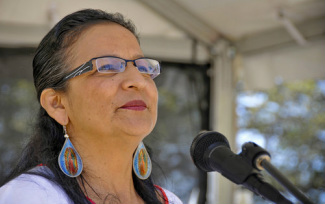 Susana Almanza recounts her work for environmental justice Susana Almanza recounts her work for environmental justice Tags: environment, health/medicine, inequality, race/ethnicity, social mvmts/social change/resistance, environmental justice, environmental racism, subtitles/CC, 00 to 05 mins Year: 2012 Length: 4:03 Access: YouTube Summary: In this video Susana Almanza explains how, historically, communities of color, Latinos, African-Americans, Asian-Americans and Native-Americans, have been disproportionately affected by industrial pollution. At the same time, these communities have not benefited equitably from these industries. She describes East Austin, Texas, where a power plant, fuel storage tank farms, refineries, lumber companies, and high tech industries regularly emit their pollutants into the air and water. In the video she goes on to describe the efforts of social movement activists, which led to the relocation of a gas tank farm that had been emitting toxic chemicals in the community for over 35 years and causing chronic illnesses for neighborhood residents. This short video could be used as an example of a successful social movement. The video might also serve as a platform for launching into much deeper discussions about environmental justice and environmental racism. Submitted By: Erika Giesen  This child has a rare disorder and is nearly blind from Agent Orange. This child has a rare disorder and is nearly blind from Agent Orange. Tags: environment, globalization, health/medicine, war/military, agent orange, chemical warfare, dupont, vietnam war, 00 to 05 mins Year: 2012 Length: 4:09 Access: New York Times Summary: This New York Times video examines the relationship between chemical war and the long-term effects on human health. As The New York Times reported in the accompanying article, "Over a decade of war, the United States sprayed about 20 million gallons of Agent Orange and other herbicides in Vietnam, Cambodia and Laos, halting only after scientists commissioned by the Agriculture Department issued a report expressing concerns that dioxin showed 'a significant potential to increase birth defects.' By the time the spraying stopped, Agent Orange and other herbicides had destroyed 2 million hectares, or 5.5 million acres, of forest and cropland, an area roughly the size of New Jersey." Forty years later, there are areas where no plant life will grow and the human health toll is becoming more clear. One example of this is the child in the image here, who has a rare bone marrow disorder that has made him nearly blind and has required he has a blood transfusion every 2 weeks. As a result of long-term effects like this, many Vietnamese people continue to hold bitterness toward the US government and argue that the US has not taken responsibility for its activities, which many people believe were criminal. In 2012, the US government launched its first program to clean up some of the Agent Orange (which includes $43 million in funding to clean up one site where the soil remains highly contaminated and provide a program to help disabled victims). One American advocate of providing this assistance says that the key to securing US cooperation is to focus on assisting the disabled and not focus on who was responsible; he argues "after so many years, why waste time arguing about the past? why get involved in the blame game?... Let's help everyone in need." Some critics say this does not go far enough and some parents of the victims want financial compensation. Viewers may consider whether the US has responsibility for the long-term effects of Agent Orange in Vietnam? What responsibilities does this include and are they going far enough? For example, does the US owe financial reparations to victims? Does Dow Chemical (the manufacturer of Agent Orange) have any responsibility? Submitted By: Paul Dean  Scene from LA Times video, "The Challenge Ahead" Scene from LA Times video, "The Challenge Ahead"
Tags: abortion/reproduction, consumption/consumerism, demography/population, environment, food/agriculture, globalization, inequality, rural/urban, 06 to 10 mins
Year: 2012 Length: 5:12 Access: Los Angeles Times Summary: This short video, "The Challenge Ahead: Rising Numbers, Shrinking Resources," accompanies a five-part series from the Los Angeles Times and highlights the causes and consequences of the global population explosion. Demographers anticipate continued population growth driven by the reality that there are now 3 billion people on the planet under the age of 25, and about 1.2 billion of them are adolescents who are entering their reproductive years. Projections suggest that by 2050 there will be well over 9 billion people on the earth, and the video highlights many of the resource demands of this many people. For instance, Jonathon Foley of the Institute on the Environment asks, "how are we going to feed 9 billion people without trashing the planet?" and Joel E. Cohen notes that humans are currently consuming resources on planet earth as if the earth were about 50% more productive. The connection between consumption (and production) and population is also explored in Foley's 2011 Ted Talk, where he reports that the total area humans are currently using for agriculture is about the size of South America (16 million square kilometers), while the total area used as pasture and range land is about the size of Africa (30 million square kilometers). Humans are also currently using about 50% of Earth's fresh water, and of this share, about 70% is used for agriculture. But after connecting population growth to agricultural demands, it is only a short distance to discussions exploring the connections between population and environmental degradation, or even climate change. After all, as Foley also points out in his Ted Talk, agricultural activity is by far the largest contributor of greenhouse gases. Thus "The Challenge Ahead" is an excellent teaser for any introduction to the field of demography, and it can be used to spur discussion about the importance of the field for tackling some of the most formidable challenges of the twenty-first century. Note that The Sociological Cinema has previously recommended clips that explore problems associated with population (here, here, and here). Submitted By: Lester Andrist 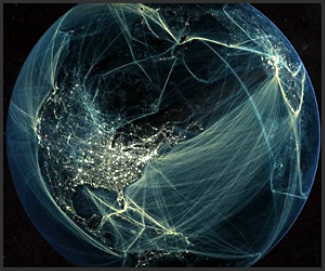 Tags: demography/population, environment, food/agriculture, globalization, inequality, rural/urban, anthropocene, great acceleration, subtitles/CC, 00 to 05 mins Year: 2012 Length: 3:29 Access: YouTube Summary: In sparkling electric blue, this narrated visualization illustrates the impact humans have had on the Earth's ecosystems from the time of the industrial revolution to the present. Referring to a new geological epoch, the narrator boldly announces, "Welcome to the anthropocene." The anthropocene is marked by the decisive role humans now play in shaping the state, dynamics and future of the Earth system. Among other indicators, scientists point out that anthropogenic processes now account for more sediment transport than natural processes, such as the erosion from rivers. Humans have also measurably altered the composition of the atmosphere, oceans, and soils, as well as the cycles associated with elements such as carbon, nitrogen, and phosphorus. The more than seven billion of us who currently reside on the planet now breath a chemically altered atmosphere of our own making, and we are witnessing the spread of oceanic dead zones. From a sociological standpoint, the adjective "anthropogenic," which simply denotes something that is produced by humans, is imprecise. It is not the mere presence of billions of homo sapiens which has altered the Earth's systems; rather, it is the way homo sapiens interact with the Earth's systems—our social processes. The clip works well as a way to enter into a discussion about environmental sociology. Specifically, one could easily draw on it to highlight the tension between understanding how changes in the environment get framed as problems by scientists, media, and other social actors, and how certain environmental changes have a real ontological status, irrespective of that framing. Submitted By: Lester Andrist |
Tags
All
.
Got any videos?
Are you finding useful videos for your classes? Do you have good videos you use in your own classes? Please consider submitting your videos here and helping us build our database!
|
 RSS Feed
RSS Feed
